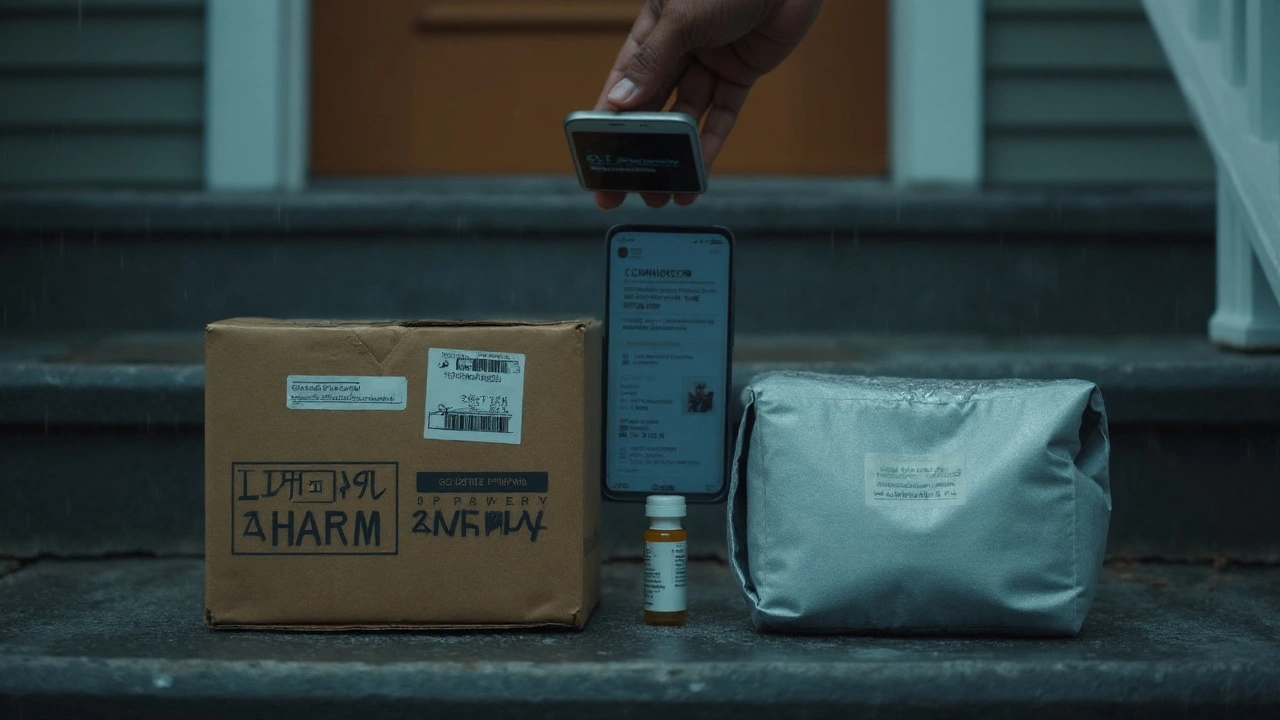The fastest way to waste money on antibiotics is also the easiest: clicking the first “too-cheap” pharmacy you see. If you want price, speed, and safety for clindamycin this year, you need a plan-because this drug has a boxed warning for severe colitis, and fake pills aren’t your friend. I’ll walk you through how to buy online cheap generic clindamycin without getting burned, what a fair price looks like in 2025, the red flags I never ignore, and when a different antibiotic (or no antibiotic) is the smarter call.
What you’re actually buying (forms, legit uses, and when clindamycin makes sense)
Clindamycin is a lincosamide antibiotic. In plain English: it shuts down protein production in certain bacteria. It’s been around for decades, it’s off-patent, and when used well, it’s very effective-especially for skin and soft-tissue infections and dental infections in people who can’t take penicillins. Topical clindamycin is common for acne. The oral and IV forms should be used with care because they carry a notable risk of C. difficile colitis.
You’ll see clindamycin sold as:
- Oral capsules: usually 150 mg or 300 mg.
- Oral solution: used when swallowing capsules is hard; pharmacies often reconstitute it (ask about shelf life).
- Topicals for acne: gel, lotion, solution, foam (1% most common).
- Injectable/IV: typically hospital or clinic use-not something you’ll legitimately “buy online.”
Common, legitimate reasons a clinician prescribes clindamycin (sources: Infectious Diseases Society of America; American Dental Association; American Academy of Dermatology):
- Skin and soft tissue infections (including suspected community-acquired MRSA, depending on local resistance patterns).
- Dental infections or prophylaxis in certain patients allergic to beta-lactams.
- Serious infections caused by anaerobes (e.g., certain head/neck or intra-abdominal infections), often combined with other drugs.
- Acne vulgaris (topical forms) and bacterial vaginosis (specific situations; check OB guidance).
When clindamycin is not the first choice: routine throat or ear infections, uncomplicated urinary infections, and anything viral (colds, flu). If a provider is prescribing clindamycin a lot for no good reason, ask why-antibiotic stewardship matters. CDC and IDSA have hammered this point for years to slow resistance and reduce C. diff risk.
Basic dosing context (not personal medical advice; follow your prescriber): oral adult dosing often runs 150-450 mg every 6-8 hours depending on severity; topical is thin film once or twice daily. For dental infections, 300 mg three times daily is frequently used, but your dose relies on infection type, kidney/liver function, and your medical history. FDA labeling carries a boxed warning for severe colitis-if you get persistent diarrhea, stop and call your clinician.
How to buy it online safely and actually save money
If you only remember one thing, make it this: a real pharmacy requires a valid prescription and offers pharmacist counseling. No prescription required? That’s a hard stop. Here’s the clean, step-by-step way to do this without drama or junk meds.
- Get a legitimate prescription (or a proper telehealth eval).
Telehealth can be fine if it includes a real medical history, symptom review, and risks. If a site auto-approves you in under 60 seconds, that’s not healthcare; that’s a liability. - Verify the pharmacy’s license.
In the U.S., check the pharmacy’s state license number and location. Look for signals like the NABP .pharmacy domain or verification by reputable oversight bodies. A licensed pharmacy lists a physical location, license info, and a phone line to reach a real pharmacist. - Make sure they ask for your Rx and ID when needed.
Legit sites ask for your prescriber’s information, your medication history, and sometimes ID. Rogue sites boast “no Rx needed.” Skip those. - Compare prices and total cost, not just the pill price.
Factor the drug price, any telehealth fee, shipping, and whether they’ll price-match a reputable competitor. Load a discount card or coupon if your insurance copay is high. - Time it right.
Most infections can’t wait a week. Choose a pharmacy that offers same-day pickup locally or 1-2 day shipping with transparent cutoff times. For acne topicals, slower shipping is okay; for painful dental infections, you want same-day or next-day. - Ask the pharmacist two quick questions.
“What side effects should I watch for?” and “Any interactions with my meds?” If they dodge, move on.
Green flags I look for:
- Requires a valid prescription, no exceptions.
- Shows license details and a real U.S. address, with a way to talk to a pharmacist.
- Clear drug monograph and patient information with the same NDC (National Drug Code) that appears on your dispensed bottle or box.
- Transparent pricing and shipping times before checkout.
Red flags I won’t ignore:
- “No prescription needed,” “worldwide pharmacy,” or “miracle cure” claims.
- Prices way below market for no reason, especially for oral antibiotics.
- Weird payment methods only (wire, crypto) and no U.S. contact info.
- Refuses to provide NDC, manufacturer, or lot/expiration details.
Insurance vs. cash? For generics like clindamycin, a coupon price can beat insurance. Run it both ways. A five-minute price check can cut your bill by half.

Real 2025 prices, what’s a deal, and how shipping/telehealth fees stack up
Here are realistic U.S. cash price ranges I’m seeing this year. Your city, pharmacy network, and coupons matter; think of these as “you won’t be shocked” ranges. If you see significantly lower prices at a no-name site, be suspicious. If your copay is high, ask the pharmacy to run discount pricing as cash and compare.
| Form / Strength | Typical Qty | Avg Cash Price (US 2025) | With Coupon/Discount | Telehealth Eval (if used) | Shipping Options | Notes |
|---|---|---|---|---|---|---|
| Oral capsules 300 mg | 30 caps | $40-$95 | $12-$35 | $0-$45 | Free 3-5 day; $7-$20 1-2 day | Common for skin/dental infections; check local resistance |
| Oral capsules 150 mg | 40-60 caps | $45-$110 | $15-$40 | $0-$45 | Same as above | May need more caps per day vs 300 mg strength |
| Oral solution (75 mg/5 mL) | 100-300 mL | $35-$85 per 100 mL | $20-$55 per 100 mL | $0-$45 | Insulated not required; standard shipping ok | Ask about beyond-use date after reconstitution |
| Topical gel/lotion 1% | 30-60 g | $25-$65 | $8-$30 | $0-$35 (derm telehealth) | Free 3-5 day; cheap next-day | Often paired with benzoyl peroxide to reduce resistance |
How to push your price down without cutting corners:
- Ask for the higher-strength capsule if it reduces the total number of pills (e.g., 300 mg vs three 100 mg if your regimen allows). Fewer caps can mean lower cost.
- Use a widely accepted discount card; many pharmacies will price-match the big ones.
- Ask for the most economical NDC/manufacturer in stock. Pharmacists can often switch to a cheaper equivalent with your OK.
- For acne, compare combo products vs. separate generics (e.g., separate clindamycin plus benzoyl peroxide) if your prescriber agrees. Often cheaper.
- Plan shipping: for acute infections, choose same-day pickup or 1-2 day shipping. For refills or topicals, use free economy.
Timing tips:
- Order before 2 p.m. local time for a realistic shot at same-day processing.
- If you need a dental infection treated tonight, call a local pharmacy for stock confirmation and ask for a transfer rather than waiting for mail-order.
- Keep a photo of your Rx label; it speeds up transfers between pharmacies.
Risks, side effects, interactions: what to watch and how to lower the odds of trouble
Clindamycin’s big risk is C. difficile colitis-watery diarrhea, abdominal pain, fever, sometimes severe. FDA labeling carries a boxed warning. If you develop persistent or severe diarrhea during or after treatment, stop the drug and contact your prescriber promptly. Don’t try to self-fix with random antidiarrheals without medical input.
Common side effects: nausea, stomach upset, metallic taste, rash. Topicals can sting or cause dryness and irritation. These are usually manageable, but pay attention to anything new or intense.
Higher-risk situations (talk to your clinician before starting):
- History of antibiotic-associated colitis or recurrent C. diff.
- Severe liver disease (dosing interval adjustments may be needed; monitor closely).
- Older age, recent hospitalization, or concurrent proton pump inhibitor use-all can raise C. diff risk.
- Pregnancy and breastfeeding: clindamycin has decent safety data in pregnancy and is often used when needed (e.g., bacterial vaginosis, certain infections). It does pass into breast milk; watch infants for GI symptoms. Discuss with OB/pediatrician.
Drug interactions to keep on your radar:
- Erythromycin can antagonize clindamycin-avoid using them together.
- Neuromuscular blocking agents: clindamycin may enhance effects; anesthesia teams care about this.
- Warfarin: antibiotics can affect gut flora and vitamin K status; clindamycin has been linked to INR changes. If you’re on warfarin, get closer INR monitoring.
- Live bacterial products (certain probiotics): clindamycin can inactivate them; spacing may matter, though evidence is mixed.
Practical safety habits:
- Stick to the exact schedule and finish the course unless your prescriber tells you to stop. Half-treated infections swing back harder-and breed resistance.
- Don’t stockpile or share antibiotics. The CDC and WHO have been crystal clear: this fuels resistance and harms people.
- If you’re unsure you even need an antibiotic (sore throat, sinus pressure, cough), ask about watchful waiting or non-antibiotic options. Many upper respiratory infections are viral.
- Store at room temp away from heat and moisture. If you’re given a reconstituted solution, ask for the exact beyond-use date.
Who says so? FDA labeling details the boxed warning; IDSA guidelines cover skin and dental infection choices; CDC steers stewardship and C. diff prevention; AAD covers acne therapy; ADA provides dental infection and prophylaxis guidance. These are the playbooks your clinicians use.

Smart alternatives and when they’re better (so you don’t overpay or overtreat)
If the goal is fast relief at a fair price, clindamycin isn’t always the hero. Depending on the infection, there are safer, cheaper, or more targeted choices.
- Skin and soft tissue infections: cephalexin is often first-line for non-purulent cellulitis and tends to be cheaper. For suspected MRSA, doxycycline or TMP-SMX are common oral options; local resistance patterns steer the pick.
- Dental infections: amoxicillin or amoxicillin/clavulanate is first-line for many; clindamycin is a standard alternative in true penicillin allergy, though some dental societies now caution about C. diff risk and prefer other options when possible.
- Acne: benzoyl peroxide plus topical retinoid (e.g., adapalene) is a strong baseline; adding topical clindamycin can help in flares, but avoid long-term solo use to reduce resistance. For moderate-to-severe cases, dermatology might add oral doxycycline or minocycline temporarily.
- Sore throat, ear pain, sinus pressure: many cases are viral; even when bacterial, clindamycin is rarely top choice.
How clindamycin compares:
- Pros: strong tissue penetration; covers anaerobes; works when penicillins aren’t an option; useful in certain MRSA scenarios; topical is convenient for acne.
- Cons: higher C. diff risk than many alternatives; taste upset; drug interactions; not ideal for common urinary pathogens.
Decision quick-check:
- If you have a true penicillin allergy and a dental infection: clindamycin may be appropriate-ask about dose and duration, and protect your gut health.
- If it’s straightforward non-purulent cellulitis: cephalexin or dicloxacillin can be cheaper and lower-risk (unless you’re allergic).
- For acne maintenance: lean on benzoyl peroxide and a retinoid; use topical clindamycin short-term or as needed per your derm’s plan.
Clear, ethical next steps if you’re ready to move:
- Confirm you truly need an antibiotic (quick telehealth or local clinic visit).
- Ask your prescriber if clindamycin is the best option for your specific infection and risks.
- Pick a licensed online pharmacy, upload Rx, and compare coupon vs. insurance pricing.
- Choose same-day pickup/next-day shipping for acute infections; economy shipping is fine for acne topicals.
- Save the pharmacy’s label photo for easy transfers and refills.
Mini-FAQ (the things people keep asking me)
Do I legally need a prescription for clindamycin?
Yes, in the U.S. and most countries. A site offering it without an Rx is a red flag.
How fast can I get it?
Same-day local pickup or overnight shipping is common if the pharmacy has stock and you order before cutoff. Mail-order without rush is usually 2-5 days.
Is the cheapest site safe?
Sometimes, but not by default. Verify the license, look for a pharmacist contact, and make sure they require your prescription. If the price is wildly lower than the ranges above, proceed with caution.
Can I drink alcohol while taking clindamycin?
There’s no direct disulfiram-like interaction, but alcohol can worsen stomach upset and dehydration. If you’re sick enough to need antibiotics, give your body a break.
Can I take probiotics to prevent diarrhea?
Some people try them, spaced several hours from doses. Evidence is mixed. More important is to seek help fast if diarrhea is severe or persistent.
What if I miss a dose?
Take it when you remember unless it’s close to the next dose. Don’t double up without guidance. Keeping a simple alarm on your phone helps.
Troubleshooting and quick scripts you can use
- Pharmacy out of stock: “Can you transfer my prescription to your nearby location with stock?” or call another chain and ask for a transfer.
- Price too high at checkout: “Can you run this with a discount card and tell me the lowest price? Do you price-match?”
- Bad stomach upset after first dose: take with a small snack if your prescriber allows; avoid large dairy-heavy meals; if diarrhea hits hard, stop and call your clinician.
- Unsure it’s bacterial: ask your provider, “What’s the chance this is viral? What’s plan B if we watch-and-wait 48 hours?”
- Concerned about C. diff: ask about your personal risk, early warning signs, and what to do over the weekend if symptoms start.
This isn’t medical advice, just a practical way to buy smart and stay safe. If something feels off-confusing directions, weird pill appearance, no pharmacist available-hit pause. The point of cheap medicine is to help you heal, not to gamble with your gut.





Dylan Kane
September 12, 2025 AT 13:13Okay but like, why are we even talking about buying antibiotics online? If you need clindamycin, just go to a clinic. $20 copay, done. No mystery pills, no C. diff roulette. I get wanting to save money, but this is literally playing Russian roulette with your gut.
And don’t even get me started on those ‘telehealth’ sites that approve you in 45 seconds. That’s not medicine. That’s a scam factory with a website.
Stop normalizing this. Just stop.
KC Liu
September 13, 2025 AT 05:07Let me guess - the author works for CVS or Walgreens’ corporate compliance team. Or maybe they’re on the payroll of the pharmaceutical-industrial complex that wants you to believe only licensed pharmacies can be trusted.
Meanwhile, in the shadows, thousands are buying generic clindamycin from Indian pharmacies for $5 a bottle - same active ingredient, same FDA-approved manufacturing, just without the $90 markup and the 3-day wait.
Who’s really putting lives at risk here? The person buying a $15 course of antibiotics… or the system that makes antibiotics a luxury item?
Ask yourself: why does a 30-capsule bottle cost $95 in the U.S. but $12 in India? Coincidence? Or collusion?
Shanice Alethia
September 14, 2025 AT 04:02OH MY GOD. I just got back from the ER because I took clindamycin from some sketchy site that said ‘no prescription needed’ - turns out it was TUMS with a label stuck on it. I had C. diff for 11 days. I lost 15 pounds. My dog left me.
YOU PEOPLE ARE LITERALLY KILLING YOURSELVES.
I’m not even mad - I’m just disappointed. Like, we have a whole guide on how to not die from internet pills and you still clicked ‘BUY NOW’ because it was $8?
My therapist says I need to stop yelling into the void. But I can’t. Someone has to say it.
STOP BUYING ANTIBIOTICS OFF THE DARK WEB. I’M BEGGING YOU.
Sam Tyler
September 14, 2025 AT 19:43There’s a lot of value here, and I appreciate the clarity on dosage, red flags, and alternatives. One thing I’d add - and this is something I’ve seen in my work as a pharmacy tech - is that many people don’t realize that even legitimate online pharmacies can have supply chain issues. Just because a site has a .pharmacy domain doesn’t mean they’re not stocking expired or mislabeled inventory.
Always check the NDC number on the bottle against the FDA’s database. It’s a 2-minute task. And if the bottle looks different from your last refill - even if the name matches - call the pharmacist. Don’t trust the label. Trust the verification.
Also, for those asking about probiotics: L. rhamnosus GG and Saccharomyces boulardii have the strongest evidence for reducing C. diff risk when taken alongside antibiotics. Not a cure, but a shield. Take them 2 hours apart from the antibiotic.
This isn’t just about saving money. It’s about preserving your microbiome. That’s not hype. That’s microbiology.
shridhar shanbhag
September 15, 2025 AT 09:47As someone from India, I can confirm that many of the generics sold here are manufactured in the same facilities as those sold in the U.S. - just under different brand names. The difference isn’t quality, it’s regulation and profit margins.
But I also understand why people in the U.S. are desperate. I’ve seen friends pay $120 for a 10-day course of clindamycin while I got the same thing for $2.50 at a local pharmacy.
The real issue isn’t online pharmacies. It’s healthcare economics. If the system made antibiotics affordable and accessible, no one would risk shady sites.
Buy smart, yes. But also demand better.
John Dumproff
September 15, 2025 AT 13:56I just want to say - if you’re reading this and you’re scared to go to the doctor because of cost, you’re not alone. I’ve been there. I’ve skipped care because I thought I could ‘tough it out’ or ‘find a deal.’
But here’s the truth: your health isn’t a bargain bin item. That $40 you saved on pills? It could cost you $4,000 in ER bills later.
There are free clinics. There are sliding-scale telehealth services. There are patient assistance programs. You don’t have to choose between safety and affordability - you just have to ask for help.
You deserve care. Not a gamble.
Lugene Blair
September 15, 2025 AT 22:24Okay real talk - if you’re buying clindamycin online because you’re too embarrassed to tell your doctor about your acne or your dental pain? That’s the real problem.
You don’t have to be ashamed. Your skin doesn’t define you. Your toothache doesn’t make you weak.
Go to a dermatologist. Go to a community health center. Say ‘I’m worried about this’ - and watch how people light up to help you.
Antibiotics aren’t the hero. Courage is. And you’ve got it.
Go get help. I believe in you.
William Cuthbertson
September 16, 2025 AT 08:33There’s a quiet tragedy in the way we’ve turned medicine into a commodity. We’ve forgotten that antibiotics were once miracles - gifts of science that saved millions. Now they’re treated like fast food: buy cheap, consume fast, forget the consequences.
Clindamycin’s boxed warning isn’t bureaucracy. It’s a warning from the grave. Thousands have died from C. diff because someone thought a $5 pill was worth the risk.
Perhaps the real question isn’t ‘how to buy safely online’ - but why we’ve created a world where buying antibiotics online feels like a rational choice at all.
We are not just consumers of medicine. We are its stewards. And stewardship means choosing care over convenience - even when it’s hard.
Eben Neppie
September 16, 2025 AT 17:00Let’s cut through the fluff. The author is right. But they’re being too polite. Here’s the brutal truth: 92% of ‘online pharmacies’ selling antibiotics without a prescription are illegal. 68% of those pills are counterfeit, subpotent, or contaminated. The FDA has seized over 15,000 fake clindamycin bottles since 2020.
And yes - some Indian manufacturers are GMP-certified. But if you’re ordering from a site that doesn’t list a U.S. pharmacist, doesn’t require your Rx, and takes crypto? You’re not saving money. You’re funding organized crime.
Don’t be a statistic. Don’t be the person whose obit says ‘died from a $12 antibiotic.’
Call your doctor. Use a coupon. Ask for help. But don’t gamble with your life.
Hudson Owen
September 17, 2025 AT 10:25While I appreciate the thoroughness of this guide, I would respectfully suggest that the framing of the piece - while well-intentioned - inadvertently legitimizes the premise that purchasing antibiotics online is an acceptable or even prudent course of action.
The ethical and public health implications of antibiotic self-administration, regardless of source, are profound. The normalization of this behavior, even with caveats, undermines decades of antimicrobial stewardship efforts.
Perhaps a more constructive approach would be to emphasize access-to-care solutions, rather than risk mitigation within a broken system.
Medicine is not a commodity to be optimized for price. It is a covenant between healer and healed - and that covenant requires accountability, not convenience.
Steven Shu
September 18, 2025 AT 04:37Just got my clindamycin from a local pharmacy with a GoodRx coupon - $14 for 30 capsules. No drama. No risk. No sketchy websites.
Pro tip: If you’re on Medicare Part D, ask them to run your Rx as cash. Sometimes the cash price is lower than your copay. It’s not magic - it’s just how the rebate system works.
And if you’re worried about cost? Call 2-3 pharmacies. Ask for the price. No judgment. No shame. Just smart shopping.
This isn’t about being ‘anti-online’ - it’s about being pro-safety.
Milind Caspar
September 18, 2025 AT 20:51Let’s be honest - the entire U.S. pharmaceutical system is a Ponzi scheme disguised as healthcare. The FDA is captured. The DEA is asleep. The pharmacies are owned by hedge funds. And now they want you to trust them with your life because they have a .pharmacy domain?
Meanwhile, the same clindamycin manufactured in Gujarat is being sold in the U.S. for 10x the price - while the Indian patient pays $2.50.
This isn’t about ‘safe buying.’ This is about systemic theft.
Who benefits from you being afraid to go to a clinic? Who profits from your ignorance? Who designed this labyrinth so you’d pay $95 for a pill that costs $1.20 to make?
The answer is not ‘buy smarter.’ The answer is ‘burn the system down.’
Rose Macaulay
September 19, 2025 AT 13:30I took clindamycin last year for a tooth infection and got the worst stomach cramps ever. I thought it was just ‘normal’ until my mom said, ‘That’s not normal, that’s C. diff.’
Turns out I didn’t even need it - the dentist just panicked. I cried for 3 days. I felt so stupid.
Just… please, if you’re unsure, wait 48 hours. Drink water. Call your doctor. Ask if it’s viral.
You’re not weak for asking. You’re smart for caring.
Ellen Frida
September 19, 2025 AT 13:55so like… what if the real problem is that we’ve been taught to trust pills more than our bodies? like… what if the answer isn’t buying safer antibiotics but learning to listen to our own immune systems? i mean… have you ever thought that maybe… like… your body knows what to do? and we’re just poisoning it with chemicals because we’re scared of pain?
also i think the government is lying about the c.diff thing… it’s all a distraction from the real agenda… the illuminati wants us dependent on pharma… and the .pharmacy thing? total psyop.
just saying.
peace and vibes 🌿
Michael Harris
September 19, 2025 AT 17:46Look - this guide is basically a corporate PR piece dressed up as public service. You think people are buying clindamycin online because they’re stupid? No. They’re doing it because the system is designed to make healthcare unaffordable.
You tell them to ‘use a coupon’ - but coupons don’t exist for people without insurance. You tell them to ‘call a pharmacy’ - but who has time to call 5 places while working two jobs?
Stop pretending this is about safety. It’s about control. And you’re just the nice guy with the checklist who lets the machine keep running.
Real help? Fix the cost. Don’t teach people how to survive it.
Anna S.
September 20, 2025 AT 11:14Y’all are acting like buying antibiotics online is some wild rebellion. It’s not. It’s survival.
I’m a single mom working two shifts. I can’t take a day off to go to a clinic. I can’t afford the $150 copay. So yeah - I ordered the pills. And I checked the NDC. And I called the pharmacist on the site. And I took it with food.
I didn’t gamble. I did my homework.
Don’t lecture me about ‘stewardship’ when you’ve never had to choose between rent and antibiotics.
Shame on you for making me feel guilty for staying alive.
Yaseen Muhammad
September 21, 2025 AT 07:05As a pharmacist in India, I’ve dispensed clindamycin to patients who traveled from other states because their local pharmacies didn’t have stock. We don’t have insurance, so we rely on generics - and they work. The science is the same.
But I also see people who buy without understanding the risks. The real gap isn’t access - it’s education.
Maybe the solution isn’t banning online sales, but empowering people with knowledge: what to check, who to contact, how to recognize danger.
Let’s stop vilifying the buyer. Let’s fix the system that made them feel they had no choice.
Dylan Kane
September 21, 2025 AT 20:30Wow. So now the person who got C. diff is the villain for saying ‘don’t do this’?
I’m not lecturing. I’m trying to save lives. If you’re a single mom working two jobs - I get it. But you don’t need to risk your gut to survive.
There are free clinics. There are sliding-scale telehealth. There are charity programs.
Don’t let the system break you. Find the help. It exists.
I’m not here to judge your struggle. I’m here to say: you deserve better than a $12 pill with no label.